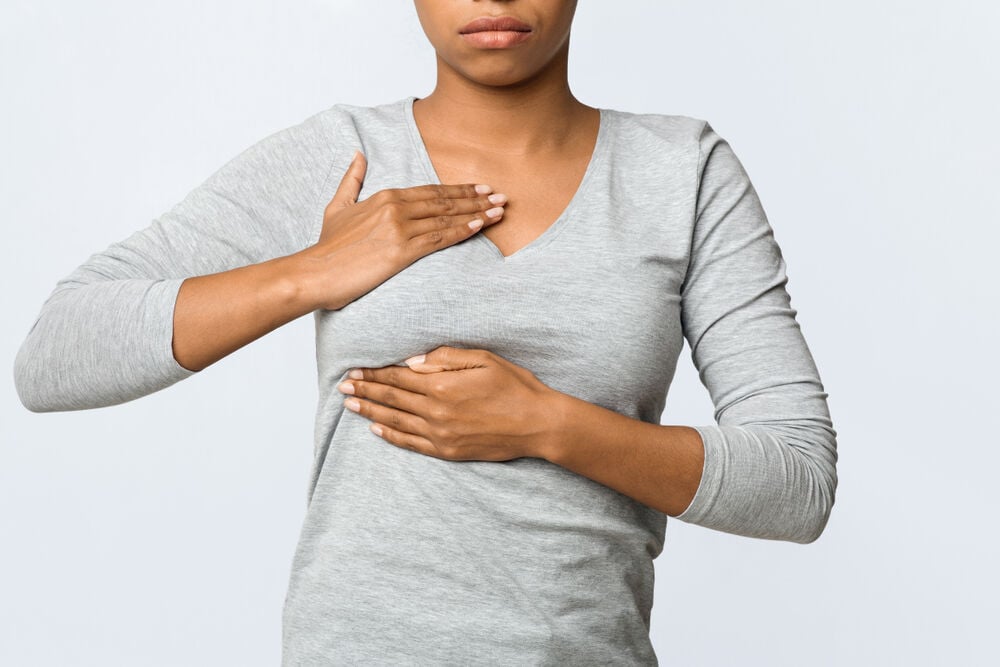Mastitis is an inflammation of breast tissue that can sometimes involve an accompanying infection. It most commonly affects breastfeeding women but can also affect anyone who isn’t breastfeeding. Read on to find out more about this condition and how it affects nursing moms and other women.
-
Tracking cycle
-
Getting pregnant
-
Pregnancy
-
Help Center
-
Flo for Partners
-
Anonymous Mode
-
Flo app reviews
-
Flo Premium New
-
Secret Chats New
-
Symptom Checker New
-
Your cycle
-
Health 360°
-
Getting pregnant
-
Pregnancy
-
Being a mom
-
LGBTQ+
-
Quizzes
-
Ovulation calculator
-
hCG calculator
-
Pregnancy test calculator
-
Menstrual cycle calculator
-
Period calculator
-
Implantation calculator
-
Pregnancy weeks to months calculator
-
Pregnancy due date calculator
-
IVF and FET due date calculator
-
Due date calculator by ultrasound
-
Medical Affairs
-
Science & Research
-
Pass It On Project New
-
Privacy Portal
-
Press Center
-
Flo Accuracy
-
Careers
-
Contact Us
Mastitis: Everything Breastfeeding Moms Need to Know


Every piece of content at Flo Health adheres to the highest editorial standards for language, style, and medical accuracy. To learn what we do to deliver the best health and lifestyle insights to you, check out our content review principles.
What is mastitis?
Mastitis is breast tissue inflammation that may also involve an infection. It can affect anyone, but particularly affects women who are breastfeeding. This type of mastitis is called lactation mastitis. Lactation mastitis affects between 2–10 percent of breastfeeding women.
The risk of developing this condition can be reduced by making sure your breast is depleted of breast milk after each feeding and by using optimal breastfeeding techniques. It’s most common in the second and third weeks after delivery, and 74–95 percent of cases happen within the first three months of a baby’s life.
It’s important to note that mastitis can occur at any stage of lactation, including within the second year of breastfeeding.
Symptoms of mastitis
Symptoms of mastitis include the following:
- Breast feeling tender or unusually warm
- Breast swelling
- Breast tissue thickening
- Pain or burning sensation from the nipple and breast area that happens continually or while breastfeeding
- Skin redness on the breast
- Generally feeling sick or run-down
- Fever of 101 degrees Fahrenheit or higher
Breastfeeding women who are affected by lactation mastitis may find it difficult to care for their baby since they can feel run-down and lethargic. Sometimes as a result of the uncomfortable symptoms, women may wean their babies sooner than they intend to, but continuing to breastfeed while taking an antibiotic is usually the best course of action for mom and baby.
Mastitis symptoms range widely in severity, whether or not there is an infection present. Some symptoms can be mild, such as inflammation, redness, warmth, and tenderness on the breast. Other mastitis symptoms can be more severe, such as fever, abscess, and septic shock, which may require a hospital stay. These last two acute symptoms are quite rare.
What causes mastitis?
Take a quiz
Find out what you can do with our Health Assistant

The primary cause of mastitis is breast milk trapped within the milk ducts. Other causes of mastitis may include:
- A blocked milk duct — If a breast doesn’t completely empty of milk during feedings, milk ducts can become clogged over time. This blockage can cause milk to back up within the duct, eventually leading to infection.
- Bacteria — Bacteria from your skin’s surface or your baby’s mouth can enter your breast’s milk ducts through a crack in the skin near or around your nipple or through a milk duct opening. The stagnant milk that remains in your milk duct provides a favorable breeding ground for this bacteria to grow and eventually result in an infection.
Lactational mastitis can also occur along with other breastfeeding problems. Other difficulties with breastfeeding might result in prolonged engorgement or poor milk drainage.
These existing breastfeeding problems might include:
- Partial milk duct blockage, which results in poor drainage
- Excessive pressure on the breast (such as from a tight bra or seat belt)
- Oversupply of breast milk
- Feedings that are not frequent enough
- Nipple cracking
- Weaning too soon
- Sickness in mother or baby
- Maternal stress
- Excessive fatigue
- Maternal malnutrition
Who’s at risk of developing mastitis?
Not all women are at risk for developing mastitis. Some factors and situations that come with an increased risk include:
- Breastfeeding for the first few weeks after childbirth
- Having sore or cracked nipples
- Using one position to breastfeed instead of multiple
- Wearing a bra that fits too tightly, putting pressure on your breasts when wearing a seat belt, or carrying a heavy bag for long periods of time — all of these things may restrict milk flow
- Previous episodes of mastitis
- Extreme tiredness or fatigue
- Poor nutrition
- Smoking
These factors can put you at risk for milk build-up in one or both breasts, increasing the risk of developing an infection in the breast tissue.
How long does mastitis last?
If symptoms of mastitis last more than 12–24 hours, an infection can develop. If you don’t notice improvement within 48–72 hours, your doctor may want to check for an abscess using an ultrasound.
If you do have an infection, your doctor may prescribe antibiotics. There are many options that are safe for breastfeeding moms to take. Antibiotics help kill the bacteria in your milk ducts and relieve any other infection-related symptoms you have, including fever.
Ways to treat mastitis
Most of the time, a doctor can diagnose whether you have mastitis and prescribe you an antibiotic to treat it, if necessary. You can also try over-the-counter treatments to help with some of the symptoms, such as pain and swelling. These might include nonsteroidal anti-inflammatory drugs, such as ibuprofen, and cold compresses to help reduce swelling.
Your doctor may also ask you to completely empty your breasts of their milk, whether or not your baby is hungry. This might involve using breast pumps or your hands to drain your breast milk. In most cases, you can continue breastfeeding your baby.
When mastitis develops into an infection, treatment consists of all of the above remedies, along with a course of antibiotics prescribed by your doctor. An infection can be confirmed by a doctor and usually involves the presence of a fever along with persistent symptoms for 12–24 hours.
Many women take part in supportive counseling to help them cope with a mastitis diagnosis. It can be a painful, frustrating experience for new parents. Emotional support for new parents is important. It’s important to understand that continuing to breastfeed is okay and perfectly safe along with continual guidance until a full recovery.
When to see a doctor
Mastitis can be a challenging condition to deal with, whether you’re a pro or brand new to breastfeeding. Anytime you have symptoms that concern you, such as a breast lump, you should see your doctor for guidance and treatment.
It’s important to get medical help sooner rather than later when it comes to conditions like this because they can result in more serious complications.
Mastitis that isn’t adequately treated or that happens as a result of a blocked duct can cause a collection of pus, called an abscess, to develop in your milk duct. Relieving that abscess usually requires draining it via a surgical procedure.
Make an appointment with your doctor if any of the following situations apply to you:
- You don’t feel better within 24 hours despite continuing to breastfeed.
- You get mastitis and you’re not breastfeeding.
- Your symptoms are not getting any better after taking antibiotics for 48 hours.
Conclusion
Mastitis can be a painful, challenging condition to cope with, but help and effective treatments are available. With treatment, you can continue to breastfeed your baby and help turn it into a more pleasant, enjoyable experience for you both.


Hey, I'm Anique
I started using Flo app to track my period and ovulation because we wanted to have a baby.


The Flo app helped me learn about my body and spot ovulation signs during our conception journey.


I vividly
remember the day
that we switched
Flo into
Pregnancy Mode — it was
such a special
moment.
Real stories, real results
Learn how the Flo app became an amazing cheerleader for us on our conception journey.




